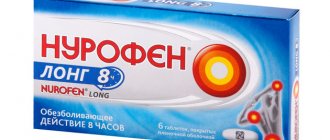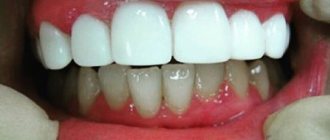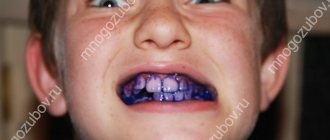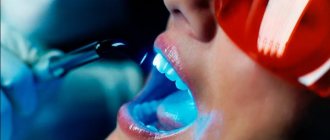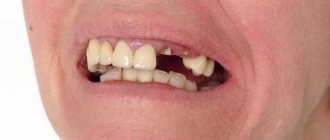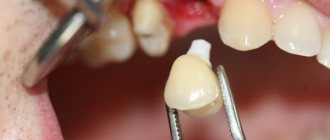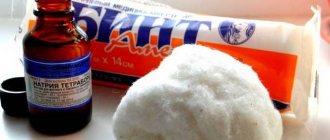February 23, 2020 Last revised: September 13, 2020 Dental diseases
Cariogenic bacteria feed on food debris that lingers in hard-to-reach areas of the dentition and harms the integrity of the enamel coating. If you do not take care of your oral cavity in a timely manner, not only the enamel layer will be destroyed, but also the internal structures of the tooth. Today we will look at what fissure sealing is used for. What does this protection provide, how long does it last, and does it harm dental health?
What is fissure sealing?
This is a new technique for preserving enamel from the harmful effects of cariogenic bacteria. Fissures are small groove-shaped depressions on the chewing plane of the lateral molars. It is in the fissures that most bacteria are found, so coating with a special composition is reliable protection and prevention of caries formation. In modern dentistry, two methods are used to seal the anatomical recesses behind the molars:
- invasive;
- non-invasive.
An invasive method of protection is carried out if the anatomical depressions are not clearly defined. Invasive sealing is prescribed after a thorough examination and the absence of contraindications.
A non-invasive technique is indicated for open fissures that are filled with dental sealant. Unlike the invasive technique, the dentist does not open the patient’s fissures.
Invasive technique
It is based on the preliminary opening of fissures, which are processed using micropreparation techniques. First, the dentist carefully sanitizes the patient’s oral cavity, removing tartar and bacterial plaque on the surface of the crowns. Then he carefully opens the fissures and dries the working surface.
After treating the tissues with orthophosphoric acid, the doctor fills the fissures with a special filling material. When the composite has completely hardened, the surface of the crown is treated with a sealant and fixed with ultraviolet light (polymerization).
After the sealing process is completed, the dentist processes the crown, grinds and polishes the surface: it is necessary to remove excess filling material that is in the way. It is performed under local anesthesia, so it does not cause pain.
Is fissure sealing performed on incisors? This makes no sense, since there are no fissures on the incisors.
Is fissure closure performed if the tooth is affected by caries on the side? The doctor will first sanitize the carious surface and then cover the enamel with sealant. Each tooth is processed separately. The presence of carious cavities on adjacent teeth is not an obstacle to sealing a molar.
Non-invasive technique
Since the fissures are open, micropreparation is not performed. The doctor carefully removes plaque and tartar (if any), dries the working surface, and applies a filling compound. After the composite material has completely dried, the surface of the molars is covered with sealant.
In order for the insulating material to properly adhere to the surface of the crown, polymerization is used - illumination with a special lamp. Next, the same work is carried out on grinding and polishing the surface of the crown to remove excess material and free the oral cavity from protruding surfaces.
Since there is no preparation involved in the non-invasive technique, anesthesia is not used. The sealing procedure is not painful or unpleasant, so patients tolerate it calmly.
Contraindications to sealing:
- untreated caries;
- a tooth that has not fully erupted;
- insufficient oral hygiene.
If the patient is careless about oral hygiene, sealing will not be done.
How long does the procedure take? This depends on the number of teeth being treated and on the sealing technique. Sometimes it can take 5 minutes, and sometimes it can take all of 45 minutes. The same applies to the price: 600 - 4,000 rubles per tooth.
To seal or not?
Whether to treat the chewing surface with sealant or not - everyone decides for himself and his child. Official dentistry has long accepted the sealing method as one of the most effective in terms of prevention. The results of professionally performed treatment are especially clear in the photographs, which show the chewing surface of the back tooth before, during and immediately after the doctor’s manipulations.
Those who are against the procedure or fear for the quality of its implementation can be recommended to consult several specialists from different clinics at once. You can choose suitable candidates based on reviews from similar patients. By comparing the opinions of several competent specialists, it will be easier to make a decision in favor of sealing.
Filling materials
The composition of the filling material varies. However, all compounds can be combined into three groups:
- composites;
- glass ionomer cements;
- compomers.
Composite materials are created on the basis of resin (sealants), they quickly harden under the influence of light or under the influence of a chemical reaction. Sealants can be less fluid or more fluid. The former are more resistant to abrasion and are more often used in invasive sealing. More fluid materials penetrate well into the deep recesses of fissures, but are less resistant to abrasion (they are replaced over time).
Glass ionomer cements are distinguished by the fact that when using them there is no need to treat the enamel with acid. The material hardens as a result of a chemical reaction and reliably protects the enamel from the invasion of cariogenic bacteria. The composition of cement includes fluorine, calcium, aluminum, and zinc.
Compomers are in many ways similar in action to cements, but have greater fluidity. They are more resistant to moisture and harden under the influence of light radiation.
The dentist decides which material to choose after a thorough examination of the patient’s oral cavity, the condition of the enamel layer, and the depth of the fissures.
Pros and cons of sealing
The advantages of the technique include:
- reliable protection against caries in both adults and children;
- caries can be stopped when its first signs appear;
- The sealant reliably fixes already installed fillings;
- protects against secondary caries.
Important! The disadvantages of sealing are not always confirmed; whether to believe the definitions of some doctors is unknown, because they are controversial. For example, some argue that such manipulation interferes with the normal growth and formation of teeth. They believe that this substance should not be applied to a child's teeth.
The second argument is that the sealant can only be applied to a flat surface, without various recesses. If one of the voids is not filled with sealant, caries may develop in it. And if its development cannot be traced, then the tooth can be lost. The third argument is that applying sealant can only be entrusted to a highly qualified specialist with extensive experience due to the need to do this as accurately and accurately as possible. This argument cannot be ignored, because in dentistry the professionalism and reputation of the doctor are very important, especially when it comes to eliminating dental problems in children.
Sealing blind pits and fissures on the chewing surface of small and large molars is an effective measure to prevent dental caries.
Sealant composition
Sealing materials are called sealants. Their composition may vary. It is customary to divide sealants into 2 types:
- transparent;
- opaque.
Transparent compounds have a certain advantage over opaque ones: they allow you to monitor the condition of the crown. If, nevertheless, carious microorganisms have begun their destructive activity, it will be possible to see this through a transparent film.
Opaque sealants are made to match the color of a milky shade. From an aesthetic point of view, this looks unattractive. However, a milk sealant defect can always be replaced if it seems “suspicious” to the doctor.
Nowadays, colored fillings and sealants have become widespread. They are given to pediatric patients. Children like colored “droplets”, and they provide adults with the opportunity to observe changes in the molar and the filling itself.
Sealants are more like an adhesive than a filling composite. The liquid structure allows them to spread evenly over the plane of the crown, sealing it from all sides. The fluid texture allows the sealant to cover even the most difficult to reach areas of the fissures. Although the sealant is fluid, its composition is strong enough to withstand chewing activity for many years.
When to do the procedure
Fissure sealing is most effective in children starting at 6-7 years of age, when the first molars begin to erupt. After sealing, you should visit your dentist regularly to monitor the condition of your teeth. This is due to the fact that the effect of the procedure lasts on average for 5-8 years, after which re-sealing may be required. Dental fissure sealing can also be done in adulthood, but such patients have significantly more contraindications to its implementation.
Fissure sealing in children
Molar sealing is used more often in children than in adults. However, the effectiveness of this technique does not depend on age: it protects molars from fissure caries. For children, the procedure is performed with sufficiently pronounced depressions, in a non-invasive way. In addition to protection, the filling composite saturates the enamel with minerals.
Only those molars that are not affected by caries are sealed.
Advantages of the technique:
- sealing teeth does not affect their growth and does not interfere with their formation;
- the sealant does not prevent the saturation of molars with minerals;
- fissure sealing does not affect the formation of bite;
- no discomfort.
Sealing fissures in childhood protects teeth from destruction by caries. Children's enamel is not strong enough; it is completely mineralized only by the age of 18. Therefore, strengthening the enamel with sealant will prevent many problems with caries in children and adolescents.
You also need to know that the enamel on the fissures of children's teeth is much thinner than on the rest of the crown. Its density will increase only two years after the formation of a permanent tooth. It is during this period that it is important to maintain the health of the enamel and prevent carious lesions.
Carbohydrate foods, pieces of which accumulate in fissures, are especially dangerous for enamel: they attract pathogens that produce acid during their life. This acid actively destroys the enamel coating, which causes caries.
The need to seal children's teeth is caused by objective reasons:
- weak fragile enamel;
- insufficient active enzymes in saliva;
- weak immunity, frequent colds.
Children suffer from colds more often than adults due to weak immunity. Colds provoke the development of caries, since the microflora of the oral cavity is populated by pathogenic microorganisms. The situation is aggravated by the lack of a conscious attitude towards oral hygiene, which provides pathogens with comfortable conditions for life.
Baby teeth
It is not always clear to parents why they need to seal baby teeth if they fall out anyway. Fissure caries is very insidious: it cannot always be immediately detected. Due to the fault of the parents, the child can develop dangerous carious cavities.
Many dentists recommend sealing baby teeth as soon as they form, before they become infected with tooth decay. If the fissures of a six-month-old baby are sealed, the effect of sealing will last up to two years. However, parents should bring their child to the dentist every 3-4 months for a check-up.
Carious lesions of tooth enamel are observed in 90% of children. Doctors recommend covering fissures with sealant already on baby teeth.
If your baby has had caries on his baby teeth, it will definitely affect his permanent teeth. Therefore, at the age of 11-12 years, it is necessary to cover the permanent teeth that have replaced them with sealant. Parents should know that tooth decay in children at the chalk spot stage can be cured if sealing is carried out in time. Therefore, take your child to the dentist regularly.
Dentists warn that the presence of healthy baby teeth has a positive effect on the condition of permanent teeth, and also contributes to the formation of a correct bite. If, due to an oversight of parents, it is necessary to remove baby teeth affected by caries, the child will develop an incorrect bite.
Silvering
Previously, silver plating was used to protect children's baby teeth. Silver nitrate prevents the development of carious cavities, but such a tooth looks unsightly. Over time, it becomes almost black, which is not very beautiful. Sealing with sealants protects the enamel just as well, but it looks almost invisible on the fissures.
Fissure diagnostics
Fissure sealing can be carried out only if there is no caries in the grooves on the chewing surface of the teeth. Therefore, dentists conduct a thorough examination, using research methods such as:
- Visual inspection. Using a mirror and a dental probe, the doctor examines the fissure area. The procedure itself is not very pleasant and can be painful for people with highly sensitive teeth. The effectiveness of this method is no more than 25%, since the doctor can mistake the anatomical features of the tooth structure for a carious lesion, or miss caries in very narrow fissures where the probe simply does not reach. Another disadvantage of this method is the possibility of damaging the enamel with the tip of the probe.
- Radiography. This method is effective only in the later stages of caries. To detect caries, patients take a photo showing the affected areas.
- Fissurotomy. Indicated when a carious lesion is detected, the size of which is difficult to determine. With the help of a special carbide bur, the fissures are opened and the affected area becomes visible.
- Electrometry. The fissure area is exposed to electric current, and the strength of this effect determines the degree of mineralization of the enamel (a kind of test of the tooth’s strength). If tooth tissues conduct current well, this may indicate carious lesions. Despite the fact that this modern method is widely used in dental practice, it does not provide one hundred percent confidence in the diagnostic results.
- Laser fluorescence method. A laser beam allows you to detect fissure caries at any stage. To date, this method is considered the most effective, its effectiveness is almost 100%.
Oral care
Do “sealed” fissures require special care? Dentists recommend performing routine hygienic procedures with the oral cavity in the morning/evening. It is necessary to carefully inspect the sealed coating in order to notice peeling or other defects in time.
Sealed materials last up to 3 years on average, you need to know about this. But some materials can last up to five years. Doctors recommend coming for examination every six months.
How long after the procedure can I eat and drink drinks? Since fissure sealing is not a medical procedure, you can have lunch immediately after treating the crowns. Dental floss, irrigators, brushes and paste are used to clean the oral cavity.
Are there any restrictions on the menu? Sealing the surface of crowns is not related to the installation of implants, so there are no restrictions on the menu. The adhesive composition can withstand any chewing load and has a large margin of safety. Therefore, there is no need to worry that the protective film will deteriorate ahead of time. Also, the film does not react to temperature fluctuations and changes: therefore, you can drink hot drinks and eat cold ice cream.
Prevention of fissure caries at home
It is important to observe prevention not only at dental appointments, but also at home. Oral hygiene is a complex procedure. It includes:
- Individual cleaning with a medium-hard brush. The necessary components of toothpaste are active calcium (ROCS, Colgate, etc.) and fluoride (President Classis, Splat, etc.);
- Using dental floss to clean the interdental spaces;
- For more thorough hygiene, it is recommended to use an irrigator;
- After traditional brushing, do not forget to rinse your mouth with sodium fluoride solutions. The optimal fluorine concentration in the solution is 250 ppm.
The prognosis for fissure caries is favorable. Thanks to planned treatment, oral sanitation and good hygiene, relapse can be prevented and complications can be avoided. To improve the condition of your teeth, you need to take care of them, as well as adhere to a balanced diet and exclude carbohydrates from your diet. Remember: healthy teeth are the guarantee of a snow-white smile.
Make an appointment with a therapist by phone+7(985)532-21-01
Tooth root caries treated or removed
Tetracycline teeth treatment, whitening, veneers
Hypoplasia of dental enamel, diagnosis and treatment
Acute traumatic pulpitis treatment in the clinic on Tverskaya, Chekhovskaya
Treatment of dental cyst without removal
Removal of a wisdom tooth cyst
Tooth granuloma, what is this disease and how to cure it
The structure of the recesses
According to their anatomical features, fissures are of the following types:
- Funnel-shaped. They have an open shape, which does not allow food debris to linger there and bacteria to develop. They are washed off the surface with saliva.
- Cone-shaped. In this type of groove, food can already be retained, so you need to constantly brush your teeth after eating.
- Drop-shaped. It is not always possible to remove food debris from such formations even with a brush. This promotes the development of bacteria on the surface.
- Polypoid. The same specifics as in the previous type.
The main points leading to the appearance of caries in fissures:
- Poor oral hygiene.
- Structure of fissures.
- Late detection of contaminated funnels.
- Inaccessibility of recesses for thorough cleaning.

